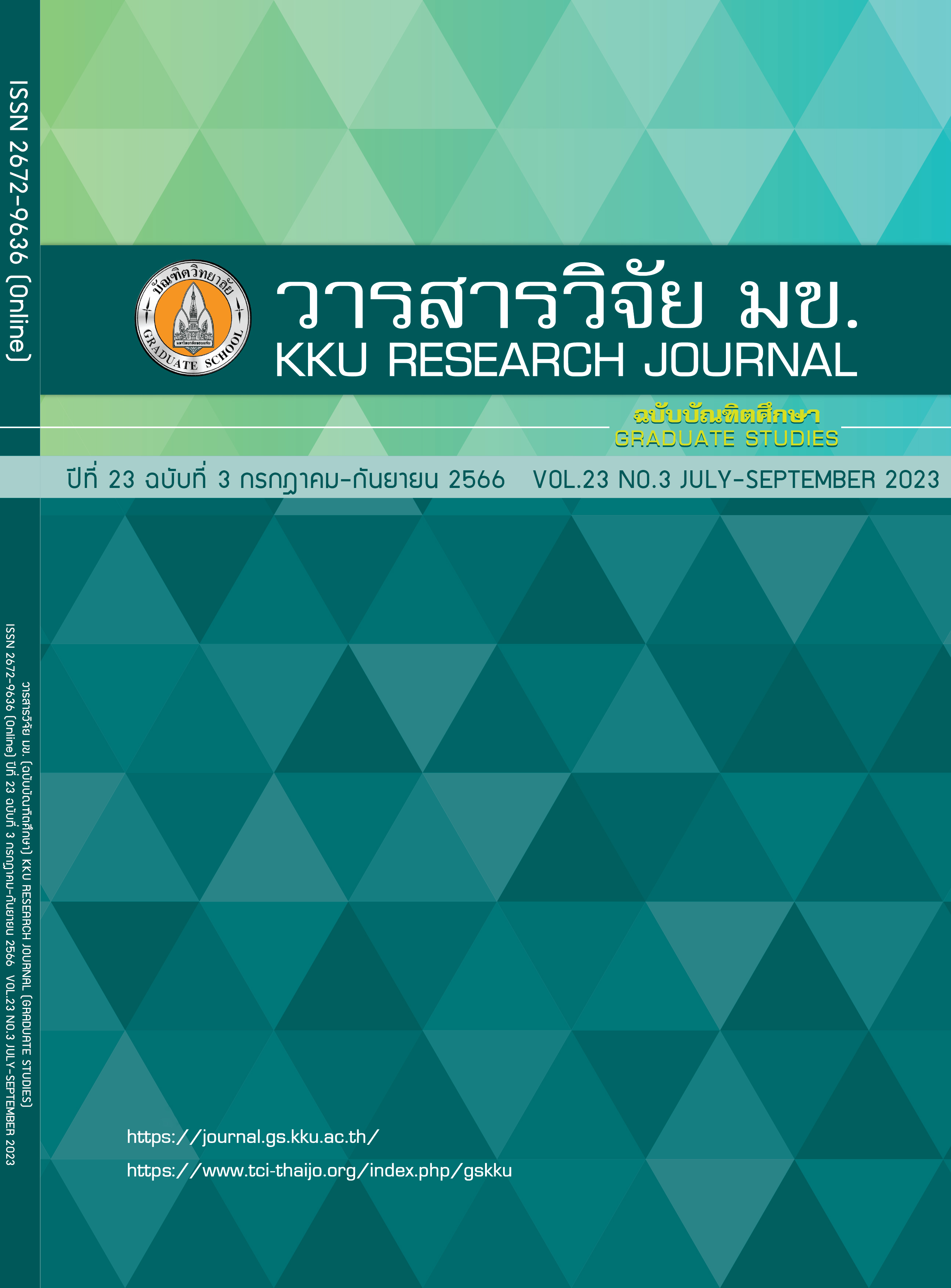การวิเคราะห์ค่าความอ่อนไหวของพารามิเตอร์ของแบบจำลอง SWAT: กรณีศึกษาพื้นที่ตอนล่างของเขื่อนลำปาว
คำสำคัญ:
แบบจำลองอุทกวิทยา, การวิเคราะห์ความอ่อนไหวของพารามิเตอร์, น้ำท่าผิวดินบทคัดย่อ
การศึกษานี้มีวัตถุประสงค์เพื่อวิเคราะห์ค่าความอ่อนไหวของพารามิเตอร์ของแบบจำลอง SWAT ที่ส่งผลต่อปริมาณน้ำท่าในพื้นที่ตอนล่างของเขื่อนลำปาว เนื่องจากพื้นที่ศึกษาเป็นพื้นที่กลางน้ำจึงได้รับอิทธิพลจากฝนที่ตกลงบนพื้นที่เอง และยังได้อิทธิพลจากน้ำท่าด้านเหนือน้ำไหลเข้าพื้นที่ ดังนั้นการวิเคราะห์ค่าพารามิเตอร์ของแบบจำลองจึงมีความสำคัญ การวิเคราะห์ใช้โปรแกรม SWAT-CUP และผลการศึกษาพบว่า พารามิเตอร์จำนวน 5 ตัว (ALPHA_BNK CH_K2 CH_N2 ESCO และ REVAPMN) มีความอ่อนไหวต่อปริมาณน้ำท่า เนื่องจากมีค่าดัชนี p-value น้อยกว่า 0.1 และค่าสัมบูรณ์ของดัชนี t-stat มีค่ามากที่สุดเป็น 5 อันดับแรก นอกจากนี้ ผลการคำนวณปริมาณน้ำท่าด้วยแบบจำลอง SWAT อยู่ในเกณฑ์ดี เพราะค่าเฉลี่ยของ R2 NSE และ PBIAS ช่วง ปี พ.ศ. 2551-2560 เท่ากับ 0.71 0.75 และ 3.85% ตามลำดับ การศึกษานี้แนะแนวทางในการสร้างแบบจำลองอุทกวิทยาให้เหมาะสมกับการประมาณปริมาณน้ำท่า
References
Lohpaisankrit W, Prasanchum H. Catchment-scale flood hazard mapping in the lower areas of Lam Pao River basin, Thailand. Eng. Access. 2022; 8(1): 53–60.
Arnold JG, Srinivasan R, Muttiah RS, Williams JR. Large area hydrologic modeling and assessment part I: Model development. J Am Water Resources Assoc. 1998; 34(1): 73–89.
Arnold JG, Fohrer N. SWAT2000: current capabilities and research opportunities in applied watershed modelling. Hydrol. Process. 2005; 19(3): 563–572.
Brighenti TM, Bonumá NB, Grison F, Mota AdA, Kobiyama M, Chaffe PLB. Two calibration methods for modeling streamflow and suspended sediment with the SWAT model. Ecol. Eng. 2019; 127: 103–113.
Worqlul AW, Ayana EK, Yen H, Jeong J, MacAlister C, Taylor R, et al. Evaluating hydrologic responses to soil characteristics using SWAT model in a paired-watersheds in the Upper Blue Nile basin. CATENA. 2018; 163: 332–341.
Abbaspour KC. SWAT-CUP: SWAT calibration and uncertainty programs - A user manual. EAWAG: Swiss Federal Institute of Aquatic Science and Technology; 2015.
Narula KK, Nischal S. Hydrological modelling of small gauged and ungauged mountainous watersheds using SWAT: a case of Western Ghats in India. J. Water Resour. Prot. 2021; 13(7): 455–477.
Land Development Department. 62 soil groups [Internet]. 2010 [updated 2010 Mar 22; cited 2022 Jul 5]. Available from: https://www.ldd.go.th/thaisoils_museum/62_soilgroup/main_62soilgroup.htm. Thai.
Khalid K, Ali MF, Rahman NFA, Mispan MR, Haron SH, Othman Z, et al. Sensitivity analysis in watershed model using SUFI-2 algorithm. Procedia Eng. 2016; 162: 441–447.
Me W, Abell JM, Hamilton DP. Effects of hydrologic conditions on SWAT model performance and parameter sensitivity for a small, mixed land use catchment in New Zealand. Hydrol. Earth Syst. Sci. 2015; 19(10): 4127–4147.
Moriasi DN, Gitau MW, Pai N, Daggupati P. Hydrologic and water quality models: performance measures and evaluation criteria. Trans. ASABE. 2015; 58(6): 1763–1785.
Phiri WK, Vanzo D, Banda K, Nyirenda E, Nyambe IA. A pseudo-reservoir concept in SWAT model for the simulation of an alluvial floodplain in a complex tropical river basin. J. Hydrol. Reg. Stud. 2021; 33: 1000770.
Alim N, Tarigan SD, Tejo Baskoro DP, Wahjunie ED. Parameter sensitivity test of SWAT hydrological model on two different resolutions (a case study of upper Cisadane subbasin, West Java). J. Trop. Soils. 2018; 23(1): 47–53.
Downloads
เผยแพร่แล้ว
ฉบับ
บท
License
Copyright (c) 2023 วารสารวิจัย มข. (ฉบับบัณฑิตศึกษา)

This work is licensed under a Creative Commons Attribution-NonCommercial-NoDerivatives 4.0 International License.


